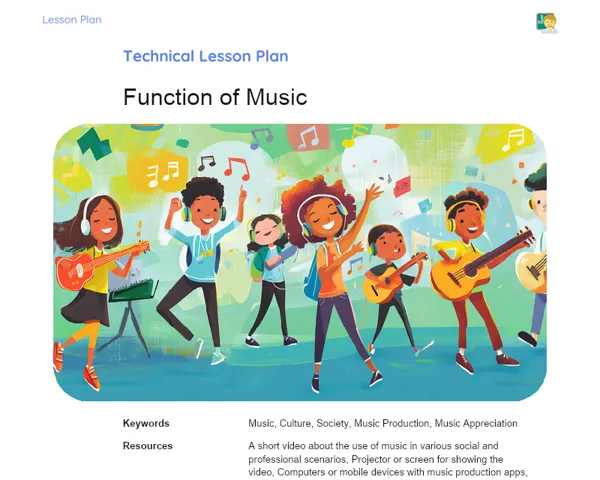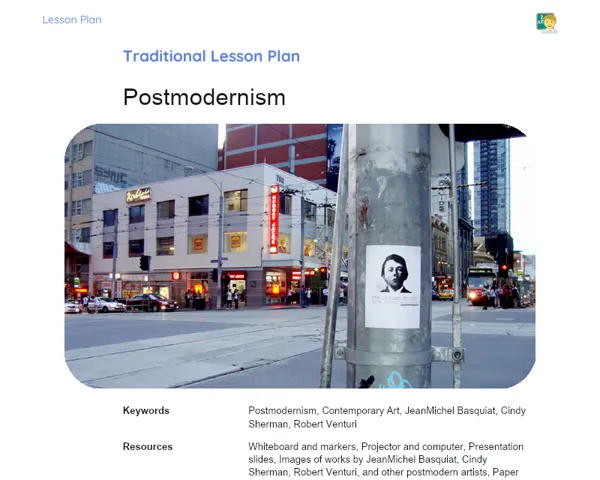Lesson Plan Teknis | Art Perception
| Palavras Chave | Perception of Art, Visual Elements, Composition Principles, Critical Analysis, Visual Arts, Line, Shape, Colour, Texture, Space, Balance, Contrast, Harmony, Creation of Artistic Works, Teamwork, Communication, Reflection, Connection to Job Market |
| Materiais Necessários | Video on art styles, Computer and projector, Paper, Coloured pencils, Paints, Brushes, Magazine cuttings, Glue, Scissors, Posters |
Objective
Duration: (10 - 15 minutes)
This phase aims to lay a solid groundwork of knowledge about the elements that contribute to visual and plastic arts. By honing these skills, learners will be able to critically analyse and interpret artworks with confidence. This is essential for developing practical skills that have direct relevance in various creative sectors, such as design, advertising, and audiovisual production.
Objective Utama:
1. Cultivate the skill to identify and describe the visual elements found in various artworks.
2. Enhance understanding of fundamental principles in visual and plastic arts, such as form, colour, texture, and composition.
Objective Sampingan:
- Encourage appreciation and curiosity about art in its various forms.
- Foster the ability to express oneself and communicate through critical analysis of artworks.
Introduction
Duration: (10 - 15 minutes)
The goal of this stage is to engage students right from the start, igniting their interest and curiosity about the topic. By linking art to real-life scenarios and career opportunities, students gain insight into the practical importance of their study. This initial activity sets the tone for an interactive and participative lesson.
Curiosities and Market Connection
Did you know that many elements of visual arts are also vital in areas such as graphic design, advertising, and audiovisual production? Professionals in these fields leverage principles like colour, form, texture, and composition to create impactful ads, appealing user interfaces, and captivating films. Understanding and applying these elements can open up career opportunities in various creative and innovative industries.
Contextualization
Art has been a powerful means of expression since time immemorial. From ancient cave paintings to the masterpieces of the Renaissance, art enables us to communicate complex ideas, emotions, and narratives. By comprehending the visual elements that constitute a piece of art, we enhance our appreciation and interpretation of the artwork and sharpen our perception of the world around us.
Initial Activity
To kick things off, show the students a short video (3-5 minutes) that showcases various art styles and visual elements. This video could range from classical to contemporary art, emphasising the primary visual elements within each style. After watching, pose a thought-provoking question: 'How might the choice of colours and shapes impact the emotions a piece of art evokes?'
Development
Duration: (70 - 80 minutes)
This stage aims to equip students with a practical understanding of visual elements and composition principles, fostering critical analysis and creativity. By the end, students should be able to recognise and employ these elements in their own creations while grasping their application across various professional contexts.
Topics
1. Visual Elements: Line, Shape, Colour, Texture, Space
2. Composition Principles: Balance, Contrast, Harmony
3. Critical Analysis of Artworks
4. Application of Visual Elements Across Different Professional Fields
Thoughts on the Subject
Guide students in contemplating how visual elements shape their interpretation of artworks. Ask: 'How can various combinations of colours, lines, and shapes impact the message of a piece?'. Encourage discussions on the usage of these elements in design, advertising, and film to engender emotions or narrate stories.
Mini Challenge
Creating a Personal Artwork
Students will be organised into groups and tasked with creating an artwork utilising different visual elements and composition principles. Each group must select a theme and apply the concepts discussed to convey a particular message through their creation.
1. Split the class into groups of 4-5 students.
2. Provide materials such as paper, coloured pencils, paints, brushes, magazine cuttings, glue, and scissors.
3. Clarify that each group must choose a theme (e.g., nature, technology, emotions) and create an artwork that communicates a message related to that theme.
4. Encourage students to incorporate a range of visual elements (line, shape, colour, texture, space) and principles of composition (balance, contrast, harmony).
5. Allocate 30 minutes for groups to discuss, plan, and produce their works.
6. After creation, have each group present their artwork and explain the visual elements and compositional choices they made.
Foster practical skills in applying visual elements and composition principles, while promoting teamwork and effective communication.
**Duration: (30 - 35 minutes)
Evaluation Exercises
1. Ask students to individually select a famous artwork and write a critical analysis, pinpointing the visual elements and composition principles present in the piece. (15 minutes)
2. In groups, students should create a small poster elucidating the relevance of visual elements in a specific professional area (e.g., graphic design, advertising, film). (10 minutes)
3. Organise a discussion circle where students share their analyses and converse about how visual elements shape their perceptions. (10 minutes)
Conclusion
Duration: (10 - 15 minutes)
The aim of this closing stage is to consolidate students' learning, providing an opportunity for reflection and discussion on the content covered. By summarising and revisiting the essential concepts, the teacher ensures that students recognise the practical importance of their learning and how to apply this knowledge in their daily lives and future careers.
Discussion
Facilitate a discussion with students about their experiences during the class activities. Ask: 'What did you find most challenging in your creations? How did the visual elements inform your decisions and final product?'. Encourage reflections on how visual elements and composition principles correlate to various professions and everyday life.
Summary
Recap the key points covered during the class, emphasising visual elements (line, shape, colour, texture, space) and composition principles (balance, contrast, harmony). Reinforce the significance of these concepts in critical analysis and creation of artworks, alongside their practical implications in fields like graphic design, advertising, and film.
Closing
Wrap up the lesson by illustrating how theory was linked to practice through hands-on activities and critical analyses. Stress the importance of developing a keen perception of visual elements, as this enhances not only artistic appreciation but also valuable skills across various creative professions. Thank the students for their enthusiastic involvement and encourage them to keep exploring the rich world of visual arts.


